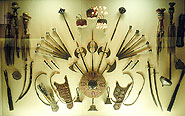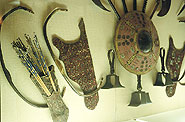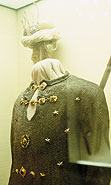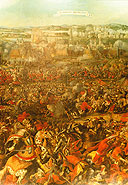
From the Austrian standpoint, a much more glorious chapter of military history than the Thirty-Years' War were the wars against the Muslim Turks. In the period of its vigorous expansion in the fifteenth and early sixteenth centuries, the Ottoman Empire had achieved notable successes against the Holy Roman Empire, conquering Hungary in the 1520s and even besieging (unsuccessfully as it turned out) Vienna in 1529. The Ottoman-Habsburg wars contined down through the seventeenth century and beyond, during which period, thanks in part to internal decline, the Ottomans gradually were driven back through the Balkans. The exhibits in the Military History Museum contain a great many objects from the wars against the Turks. As one observes the visitors to the museum today, among them Muslim Turks and Bosnians, one cannot but wonder what impression is produced by exhibits which emphasize Turkish defeats and Austrian Catholic victories. It would be of some interest to learn about a Turkish vantage point on these same wars.


The exhibits contain numerous trophies of the Austrian victories. There is a display of captured Ottoman Turkish weaponry. Bows and arrows were still extensively used by the Ottoman army and in fact were really more effective than the muskets of the period. The range of the powerful compound bow was as much as 300 m., and the rate of fire much faster than that for muskets, which required a very time-consuming process of loading and priming.

Ottoman soldiers wore chain mail. This jewel-studded chain mail shirt was captured as a trophy by Raimondo Prince Montecuccoli, one of the most successful of the Habsburg military commanders in the wars against the Turks in the middle of the seventeenth century.

In fact one of the high points in Ottoman history was the reassertion of Turkish power in Europe in the 1670s, culminating in the second great siege of Vienna in 1683, which forms a focal point of some of the museum exhibits. For the Austrians, the hero who broke the siege somewhat ironically was not one of their own but their ally Jan Sobieski, the King of Poland, whose cavalry surprised the Turks by storming down from the hills around Vienna. The King is the prominent figure on the rearing horse in the lower part of the picture. The Turkish retreat turned into a rout, and by the time peace was signed in 1699, the Turks had lost much of Hungary, and the territorial basis for what would be the Austro-Hungarian Empire had been created.